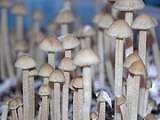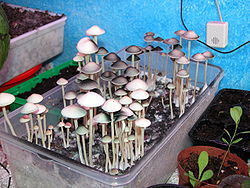
Panaeolus tropicalis
Encyclopedia
Panaeolus tropicalis is a potent hallucinogenic mushroom
which contains psilocybin
.
It is also known as Copelandia tropicalis.
is 1.5 — 2(2.5) cm and hemispheric to convex to companulate. The margin is incurved when young, clay-colored, often reddish brown towards the disc, hygrophanous
, smooth, and grayish to greenish; it is translucent-striate at the margin when wet. It becomes blue when bruised.
The gills are adnexed, distinctly mottled, and dully grayish with blackish spots.
The stipe
is 5–12 cm long, 2–3 mm thick, hollow, and vertically striate. It is blackish towards the base, greyish towards the apex, and pallid to whitish fibrils run the length of the stipe. The stipe is equal to slightly swollen at the base and lacks a partial veil
.
Panaeolus tropicalis spores are dark violet black to black, ellipsoid, and 10.5–12.0 x 7–9 µm. The basidia
each produce two spores.
The entire mushroom readily bruises blue where it is handled.
It can be differentiated from Panaeolus cyanescens
by microscopic characteristics.
, Central Africa
, and Cambodia
; it can also found in Mexico
, Tanzania
, the Philippines, Florida
, and Japan
.

Mushroom
A mushroom is the fleshy, spore-bearing fruiting body of a fungus, typically produced above ground on soil or on its food source. The standard for the name "mushroom" is the cultivated white button mushroom, Agaricus bisporus; hence the word "mushroom" is most often applied to those fungi that...
which contains psilocybin
Psilocybin
Psilocybin is a naturally occurring psychedelic prodrug, with mind-altering effects similar to those of LSD and mescaline, after it is converted to psilocin. The effects can include altered thinking processes, perceptual distortions, an altered sense of time, and spiritual experiences, as well as...
.
It is also known as Copelandia tropicalis.
Description
The capPileus (mycology)
The pileus is the technical name for the cap, or cap-like part, of a basidiocarp or ascocarp that supports a spore-bearing surface, the hymenium. The hymenium may consist of lamellae, tubes, or teeth, on the underside of the pileus...
is 1.5 — 2(2.5) cm and hemispheric to convex to companulate. The margin is incurved when young, clay-colored, often reddish brown towards the disc, hygrophanous
Hygrophanous
The adjective hygrophanous refers to the color change of mushroom tissue as it loses or absorbs water, which causes the pileipellis to become more transparent when wet and opaque when dry....
, smooth, and grayish to greenish; it is translucent-striate at the margin when wet. It becomes blue when bruised.
The gills are adnexed, distinctly mottled, and dully grayish with blackish spots.
The stipe
Stipe (mycology)
thumb|150px|right|Diagram of a [[basidiomycete]] stipe with an [[annulus |annulus]] and [[volva |volva]]In mycology a stipe refers to the stem or stalk-like feature supporting the cap of a mushroom. Like all tissues of the mushroom other than the hymenium, the stipe is composed of sterile hyphal...
is 5–12 cm long, 2–3 mm thick, hollow, and vertically striate. It is blackish towards the base, greyish towards the apex, and pallid to whitish fibrils run the length of the stipe. The stipe is equal to slightly swollen at the base and lacks a partial veil
Veil (botany)
A veil, in mycology, is one of several structures in fungi, especially the thin membrane that covers the cap and stalk of an immature mushroom.Veils may be regarded as falling into two categories:*Partial veil*Universal veil...
.
Panaeolus tropicalis spores are dark violet black to black, ellipsoid, and 10.5–12.0 x 7–9 µm. The basidia
Basidium
thumb|right|500px|Schematic showing a basidiomycete mushroom, gill structure, and spore-bearing basidia on the gill margins.A basidium is a microscopic, spore-producing structure found on the hymenophore of fruiting bodies of basidiomycete fungi. The presence of basidia is one of the main...
each produce two spores.
The entire mushroom readily bruises blue where it is handled.
It can be differentiated from Panaeolus cyanescens
Panaeolus cyanescens
Panaeolus cyanescens, also known as Copelandia cyanescens, is a mushroom in the Bolbitiaceae family. Panaeolus cyanescens contains psilocin, psilocybin and is similar to Panaeolus tropicalis.- Description :...
by microscopic characteristics.
Habitat and distribution
Panaeolus tropicalis is mushroom that grows on dung. It is most often found in HawaiiHawaii
Hawaii is the newest of the 50 U.S. states , and is the only U.S. state made up entirely of islands. It is the northernmost island group in Polynesia, occupying most of an archipelago in the central Pacific Ocean, southwest of the continental United States, southeast of Japan, and northeast of...
, Central Africa
Central Africa
Central Africa is a core region of the African continent which includes Burundi, the Central African Republic, Chad, the Democratic Republic of the Congo, and Rwanda....
, and Cambodia
Cambodia
Cambodia , officially known as the Kingdom of Cambodia, is a country located in the southern portion of the Indochina Peninsula in Southeast Asia...
; it can also found in Mexico
Mexico
The United Mexican States , commonly known as Mexico , is a federal constitutional republic in North America. It is bordered on the north by the United States; on the south and west by the Pacific Ocean; on the southeast by Guatemala, Belize, and the Caribbean Sea; and on the east by the Gulf of...
, Tanzania
Tanzania
The United Republic of Tanzania is a country in East Africa bordered by Kenya and Uganda to the north, Rwanda, Burundi, and the Democratic Republic of the Congo to the west, and Zambia, Malawi, and Mozambique to the south. The country's eastern borders lie on the Indian Ocean.Tanzania is a state...
, the Philippines, Florida
Florida
Florida is a state in the southeastern United States, located on the nation's Atlantic and Gulf coasts. It is bordered to the west by the Gulf of Mexico, to the north by Alabama and Georgia and to the east by the Atlantic Ocean. With a population of 18,801,310 as measured by the 2010 census, it...
, and Japan
Japan
Japan is an island nation in East Asia. Located in the Pacific Ocean, it lies to the east of the Sea of Japan, China, North Korea, South Korea and Russia, stretching from the Sea of Okhotsk in the north to the East China Sea and Taiwan in the south...
.


